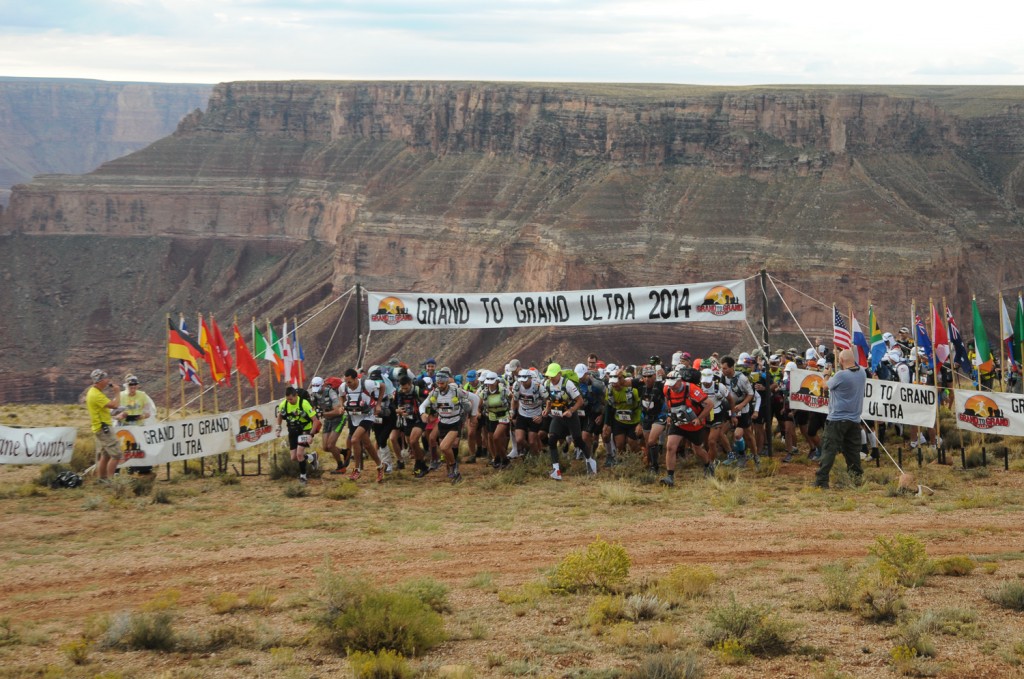
The Sept. 21 start of the Grand to Grand Ultra on the North Rim of the Grand Canyon. I’m in the lime green shirt and white hat under the “T” of “To” in the banner. Photo courtesy of Grand to Grand Ultra
I couldn’t find any rhythm in my stride while shuffling and hiking cross-country up a high-desert pasture at the base of a red-rock butte. Jagged rocks, calf-high spiky cacti and prickly scrub brush made the route an off-trail obstacle course. My eyes shifted constantly from looking down to dodge the tripping hazards, to looking up to spot the course-marking ribbons.
Each time I looked up, I saw a handful of competitors from the Top 10 pack ahead of me, and I felt self-imposed pressure to keep up so the gap between us would not widen—which left me sucking air with a racing heart at 6000 feet elevation.
I was starting Stage 2 on Day 2 of the Grand to Grand Ultra, and the reality—the enormity—of the race was sinking in and challenging my spirit like the deep sand in the tracks that made my footsteps founder.
The event divides its stages into the following mileage: 31, 27, 53, 26, 26 and 7.
I opened a zippered pouch on my shoulder to pull out and suck down a precious Gu energy gel—one of only five I had rationed for this arduous 27-mile stage. I could have used close to double the calories for each stage, but I had cut down my amount of food and gels to have a lighter-weight pack.
I was journeying with 106 other competitors across remote swaths of Northern Arizona and Southern Utah, a 20-liter pack holding all my food, clothing and sleeping gear for the week. The same shirt, shorts and bra that I would wear each day clung to my body with sweat.
Yesterday’s Stage 1 had seemed so manageable by comparison, like a fun training 50K. We had set out on fresh legs and in clean clothes from Camp 1, and we ran hard-pack road across a plateau for the first 20 or so miles before turning off trail and going cross-country up a moderately difficult hill. I finished the first stage in 12th place, early enough in the day to avoid a hailstorm that pelted and drenched the back-of-the-pack hikers.
On Stage 2, my legs—already crisscrossed with red scratches—protested with fatigue, while my feet sprouted oozing blisters that would talk to me all week.
I felt some relief when we reached the base of a 1000-foot hill after the first few miles of this stage, because there was no way that I or anyone else could run up these switchbacks, so I could justifiably downshift to a hiking gear to stretch out my legs.
Up, up, up we powerhiked, and I managed to pass a few people and find myself out of view of any others. We were climbing an old shepherding and Indian trail into the Kaibab forest. The scrub brush gave way to piñon and juniper trees, and the view glancing over my shoulder revealed a vast stretch of desert called the Paria Plateau, framed by the Vermillion Cliffs National Monument.
Looking back at the monumental distance we’d covered in just a little more than a day, I felt a surge of emotion and literally felt a little high in the thin, dry air. It hit me how far I had come (about 40 miles)—and how far I still had to go (about 130 more) over the next five days. But I was doing it! The time had actually arrived, the months of training were done, the logistics all fell into place to put me there, on a remote desert mesa, to test my strength and stamina.
I reached the ridgetop and started to run hard—that is, as well as someone can run with 20 pounds on their back over technical, rocky terrain—and to sing some favorite songs in my head. I picked lots of tracks from the playlist on the iPod I left at home—silly, so-bad-they’re-good pop tunes, like Enrique Iglesias I Like It.
Who really needs an iPod or any devices? I started singing Baby I like it… in rhythm to my stride.
During those magical miles, I was completely unplugged, off the grid and rocking out. I was going native, kicking ass and feeling half my age. And it just kept getting better.
I was glowing, radiating heat, breathing hard and dripping sweat as if from a hit of ecstasy and the foreplay to good sex.
Yes, in rare, sublime moments, trail running really feels that good. But inevitably—hilariously—something had to harsh my buzz.
It happened suddenly at the summit, when a signal from a satellite malevolently connected with the iPhone buried deep in my pack: A cacophony of text alert chirps, buzzes and bells rang out and shattered the forest’s serenity. I said out loud to myself and to no one, What the fuck?!
I thought I had my phone completely turned off. I brought it along only to take photos at the finish line, and then to make calls to family on the bus ride back to Vegas. I didn’t want to run with my frickin’ phone. But somehow, perhaps through divine intervention, it turned itself on in my pack. And the worst, funniest part was that it wouldn’t shut up with one particularly annoying notification sound. I recognized this dinging noise as the warning signal from an app called Life360, which our family put on each of our phones last summer so we could track the location of our teenagers, Colly and Kyle. My kids hated this Big Brother app. And now they were getting their payback, because Life360 was issuing dire warnings from my backpack that I was out of range and needed to check in.
I could just hear Colly and Kyle laughing. I started laughing. I said to myself, there’s no f-ing way I am stopping to take off my pack and deal with my phone, so I’ll just listen to it and let the battery drain. About 20 minutes later, it shut up, and I carried a dead phone for the remainder of the week.
I ran another couple of hours, bombing down a mountainside that took every ounce of concentration to avoid falling, and then hitting another plateau with long, hot, mostly flat miles. The temperatures climbed into the 90s, and I felt the back of my neck crisp.
Every 5 to 7 miles, we reached a checkpoint where heroic volunteers gave us water, salt pills and sunscreen. These flat, long miles were in some ways more challenging than the switchback climbs because you can see so far into the distance and realize you have to run to the horizon and beyond.
I could see a few guys near the front of the pack who gave up running and started to walk the whole way to camp. I struck bargains with myself, such as: run for four minutes, walk for one.
I plodded along, wilting in the heat. I could feel a sore opening on my skin under my shoulder strap. I tugged on my shirt, which for some reason felt like it was choking me, and I felt the area between my shoulder blades crisp in the sun.
Two guys in the distance walked side by side. I used them as motivation to run and catch up, and as I reached them maybe a half-mile from the finish line, I said, “Watch out, boys, I smell the barn!” That kicked them up a gear, and the three of us finished Stage 2 together while the volunteers and front-runners cheered for us and rang cowbells.
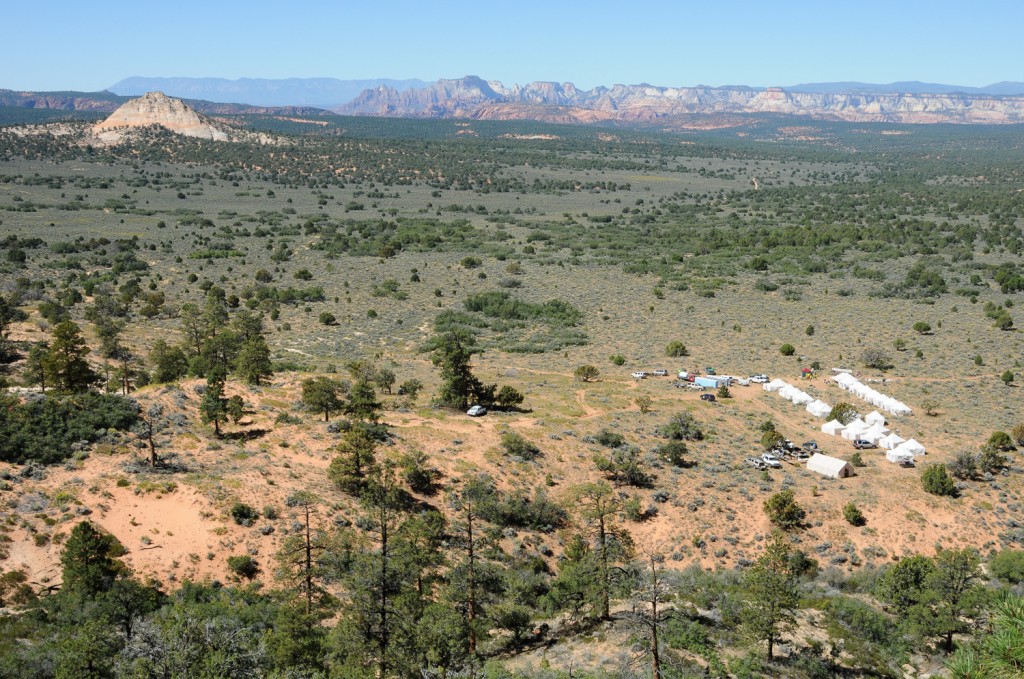
The view of Camp 2 from above, showing the terrain we ran across. Photo courtesy of Grand to Grand Ultra.
I immediately went to the gathering spot in a main tent to take off my pack, and I couldn’t suppress my feelings of relief: “Ahhhhhhh…..yes!!!!”
At that moment, when I took my pack off, I realized why my shirt felt like it had been choking me, and why the top of my back felt extra sunburned. I had put my shirt on backwards that morning, so the lower neckline exposed the top of my back. I guess that’s a risk that goes with getting dressed in the dark.
Recovery
There’s actually a lot to do once I get to camp. I find my way to our tent and pick out a spot for my sleeping bag, usually in the corner by the zippered door so I don’t have to step over people on my way to the portapotties during the night.
Each tent is numbered and given a Native American tribal name. I’m assigned to #6, Hualapai. “HUALAPI!” becomes the rallying cry between my tentmates and me.
I fill up my water bottle and mix in a package of a 170-calorie Hammer Recoverite Orange-Vanilla recovery drink. It’s disgusting, but I suppress the urge to gag because I need its protein and carbs. What I really want to gulp down are huevos rancheros smothered with guacamole, not this fake space-food, but it’s all I rationed for the afternoon. (See my gear and food post if you want the details on what I packed.)
Then I strip out of my sweaty, smelly running clothes. If someone else is in the tent, then I say, “Look away, please,” and I turn my back to them.
I packed a lightweight black camisole top and the sportiest, un-sexy boy-short-style underwear that I could find to wear around camp. In the oppressive afternoon heat, I have no qualms about walking around in underwear. Everyone is half naked. When night falls and the air cools, I put on a long-sleeve wool top and long underwear leggings, along with a lightweight down jacket.
Then I take my pile of damp, dirty running clothes outside and, using my water bottle, squirt water on the most offensively dirty parts, like the base of the bra and the crotch of the shorts. We have to ration water, so I can’t really rinse my clothes out. But I can get them wet enough with fresh water to wring out some of the salt and sweat. Then, using safety pins, I pin my clothes to the outside of our canvas tent, where they dry in the direct sun. (The sun evaporates some of the fabric’s body odor, but by midweek I am repulsed by the smell that wafts up from my chest to my nose.)
Next, I go to work on my feet—and oh, what a nasty job it is.
I change out of my running shoes and into the cheap flip-flops that I carry in an outside pocket of my pack. Then I go to the portapotties, where there is a portable hand-washing station with paper towels (a true luxury), and I recycle some paper towels from the trash that look barely used. If I’m lucky, I can score a wet wipe from the medical tent, too.
Back at the tent, I get the towels wet and clean my toes as best as I can. Each toe has a blister or a cap of dead skin over inflamed tissue. I call them “cadaver toes,” because they remind me of the tagged toes of a bloated drowned man I saw once in a morgue when I was working as a reporter.
A couple of blisters are starting to show streaks of red from infection. Both big toes’ nails are purple and angry from blood blisters under the nail bed. I’m frustrated, because I took many well-practiced measures (tape, anti-chaffing lube, etc.) to prevent blisters, yet my feet are a mess anyway. So I prep them with an alcohol wipe, get out a needle, lance them, and drain the pus and juice as best I can. I put loose Band-Aids on the punctured blisters to try to keep them clean while airing them out. A few hours later, I’ll go to the med tent to get help properly taping them for running. I’ll also ask for help applying ointment and tape over sores on my shoulder blade and lower back.
I spend a little while at the finish line cheering for runners who are coming in, and I also compose an email to family on one of the “cyber tent’s” three clunky, dusty offline laptops. (Runners have a 15-minute limit to compose outgoing email, which is sent later in the day when a volunteer transports the laptops back to civilization and goes online for sending.)
Then it’s time to rest. I lie on my back in the tent with my feet elevated on a little camp chair. This is my favorite time, because I’m lying side by side with at least two or three of my wonderful tentmates.
Michele (pronounced Mee-kay-lay, but he also goes by the nickname Mickey) is usually there, along with Roberto, since Mickey is the first finisher (he’ll end up winning the race decisively) and Roberto is in the Top 10. They’re both Italian, and their Italian conversation mixes with the mellifluous chatter of the French runners one tent over. I close my eyes, listen to the threads of conversation, and for a moment I feel as if I’m at a European spa, until the honking of farts from a neighbor’s tent rips through the moment.
Then Danny the Brit and Simon the Aussie walk in. Dan from Chicago, my tentmate from the 2012 Grand to Grand, is always one of the last ones to return to camp since he’s hiking rather than running the course, along with Sabine, my German/South African friend from San Francisco and the only other woman in our tent of seven.
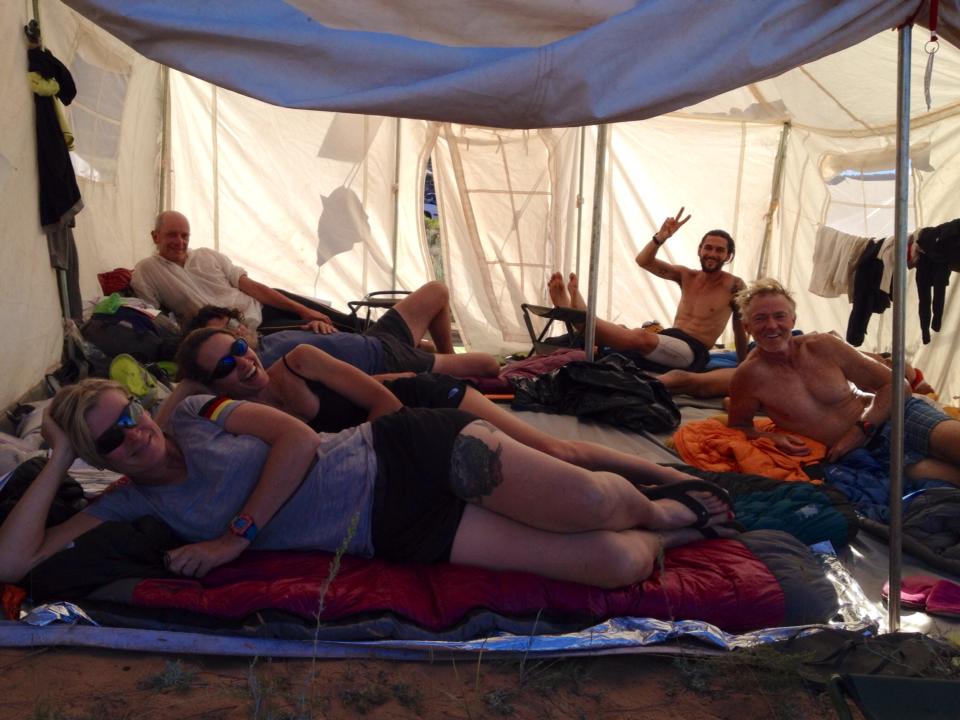
The Hualapai 7: Sabine, me behind her, then Dan and Danny behind me; on the right, Simon, Roberto (only his legs are visible because he’s sleeping) and Michele in the back corner.
Without fail, at some point during the afternoon and night, I get the giggles. It’s triggered by a “you had to be there” one-liner or a look exchanged between two of us. It might be Simon riffing on Crocodile Dundee’s line, “That’s not a knife, THIS is a knife!” Or Dan, sorting through a secret candy stash in his too-heavy pack, deviously plotting how he’ll surprise everyone with his last-stage sprint. Or Mickey, the former top underwear model now as filthy as the rest of us, describing the hole that opened in the lining of his running shorts and the surprising sensation he got when a certain something fell through, and how he reached down to try to fix it while running.
In our tent, we don’t lose all sense of modesty. Danny at least waits until I step outside to say, “Thank god Sarah is leaving so I can air out my balls.”
Our stomachs are growling by 4 p.m., but we try to hold off having dinner until 6. Sometimes I can’t wait, so I take my freeze-dried backpacker meal, fill it with hot water, and eat half at 4:30 and the other half at 6:30. Each meal is about 800 calories, loaded with salt and a good mix of protein, fat and carbs. For the six nights, I packed two each of Three Cheese Chicken Pasta, Macaroni and Cheese, and Chicken Teriyaki. They are reminiscent of airplane meals, and they are indescribably delicious.
I’m so desperate to get every morsel that when I finish eating, I fill the food bag with water and then drink from it so that I can drink the crumbs and the leftover sauce.
One night, I opened one of my bags of AlpineAire brand Three Cheese Chicken Pasta and stirred my spork through it, looking for the little silicon drying pouch you’re supposed to remove. My eye caught the glint of something silver among the green and orange freeze-dried vegetables. I dug some more to find what might be a foreign object, and pretty soon I was staring in disbelief at a piece of hardware on my spork—a round metal washer, about a centimeter across. I contemplated how horrible it would have felt to bite into it. But my calorie-deprived body was in no position to sacrifice dinner for the sake of a little factory contamination, so I removed the piece of hardware, rehydrated the food and proceeded to eat it with gusto, dismissing any thoughts of a metallic taste.
We go to bed at around 9 p.m. and I fall asleep easily, but I always wake up after midnight because I have to pee. I get out of the tent, go to the bathroom, and then spend a while just looking at the starry sky—the incredible Milky Way, as bright and visible as if seen from an observatory. I listen to coyotes crying in the distance, and I inhale the earthy air. I am so electrified by the nighttime energy that I can’t fall back asleep when I return to the tent. I toss and turn for most of the rest of the night.
Tess, the race director, wakes the camp up with blaring music every morning at 6 a.m. sharp. It might be Queen’s Another One Bites the Dust or Tom Petty’s Won’t Back Down or ABBA’s Take a Chance on Me or the Proclaimers’ I Would Walk 5000 Miles.
We sit up in the pre-dawn darkness of our tent and get ready to run for another day.
That is our only job for this week: to run, and then to recover. And I have fallen in love with this stripped-down, tribal, wild way of life.
(To be continued … with The Long Stage and the Finish … see Part 2.)
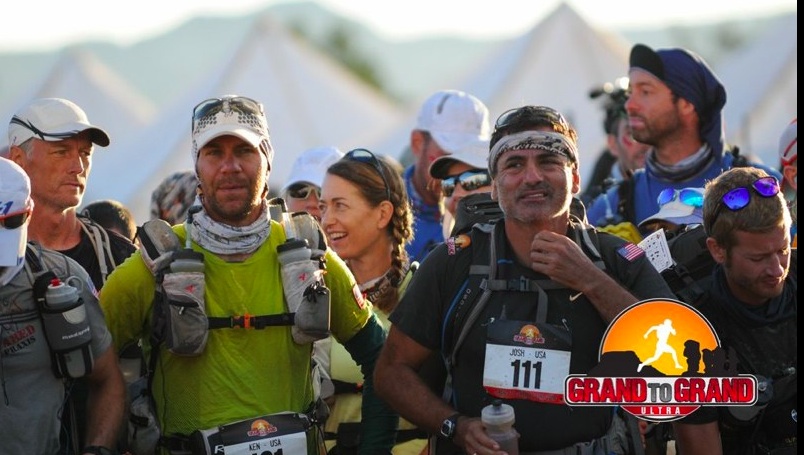
… and me at the start of another stage with a bunch of bad-asses. These last two pics are courtesy of Grand to Grand Ultra.
I’m a member of the Grand to Grand Ultra Training Team for 2015, which means I’m a recommended G2G coach and available to help runners of all levels prepare for the challenge. Read this post for more info and check out my coaching page.
To read about the Grand to Grand Ultra’s frontrunners, check out the news story I wrote for Trail Runner, which includes a Q&A with the winners.
And to hear more, listen to this UltraRunnerPodcast.com episode that I co-hosted last week, in which we interview Grand to Grand champ Michele Graglia.

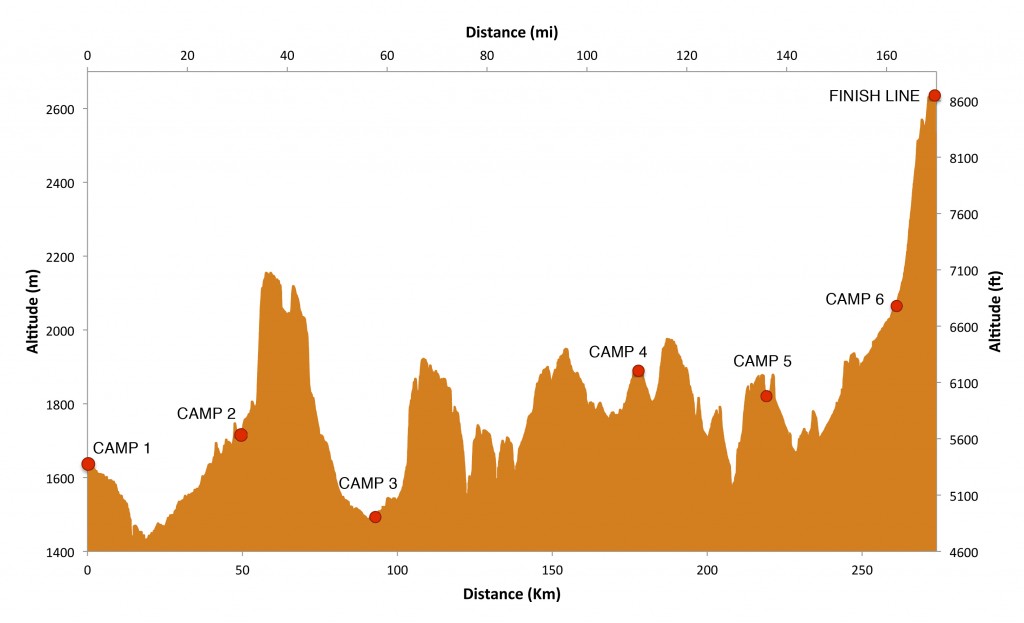
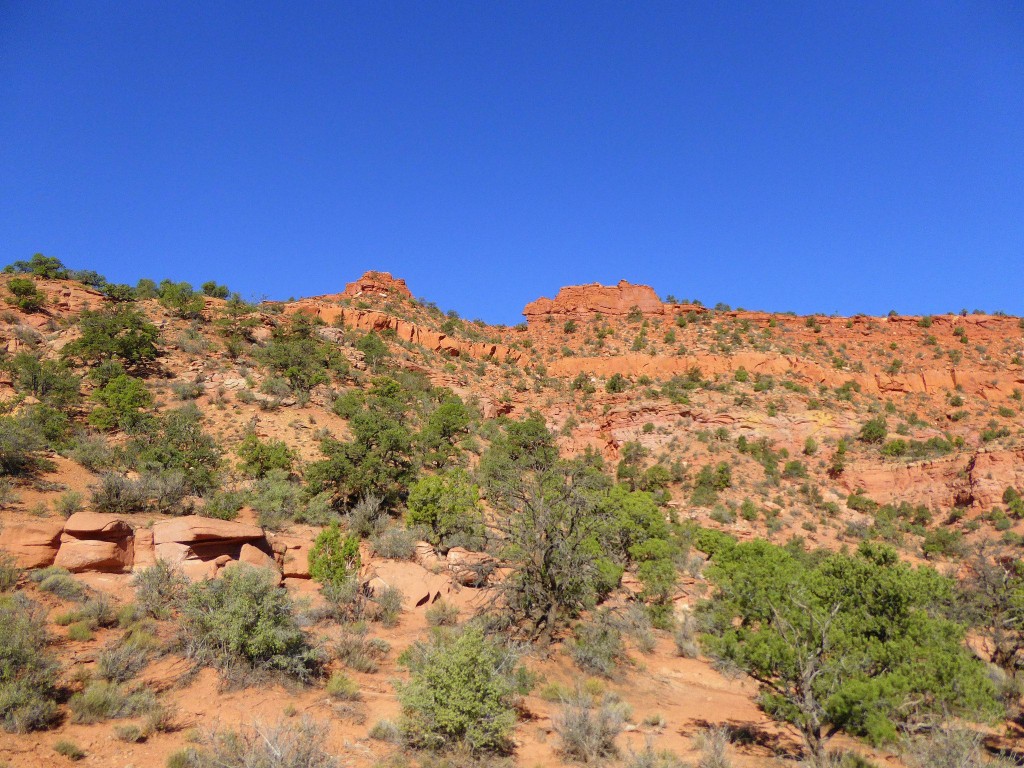

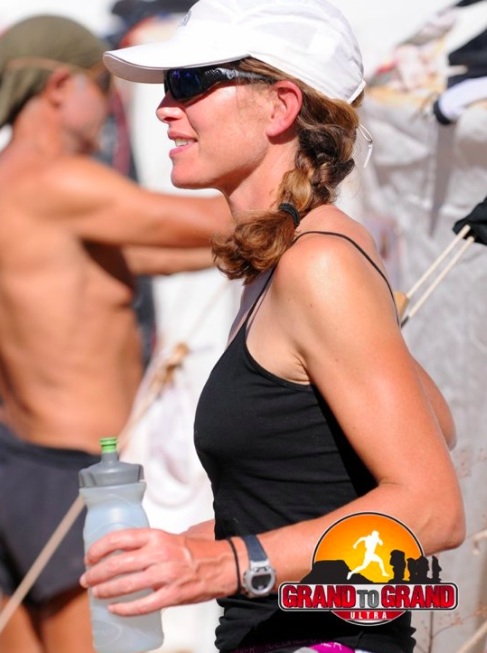
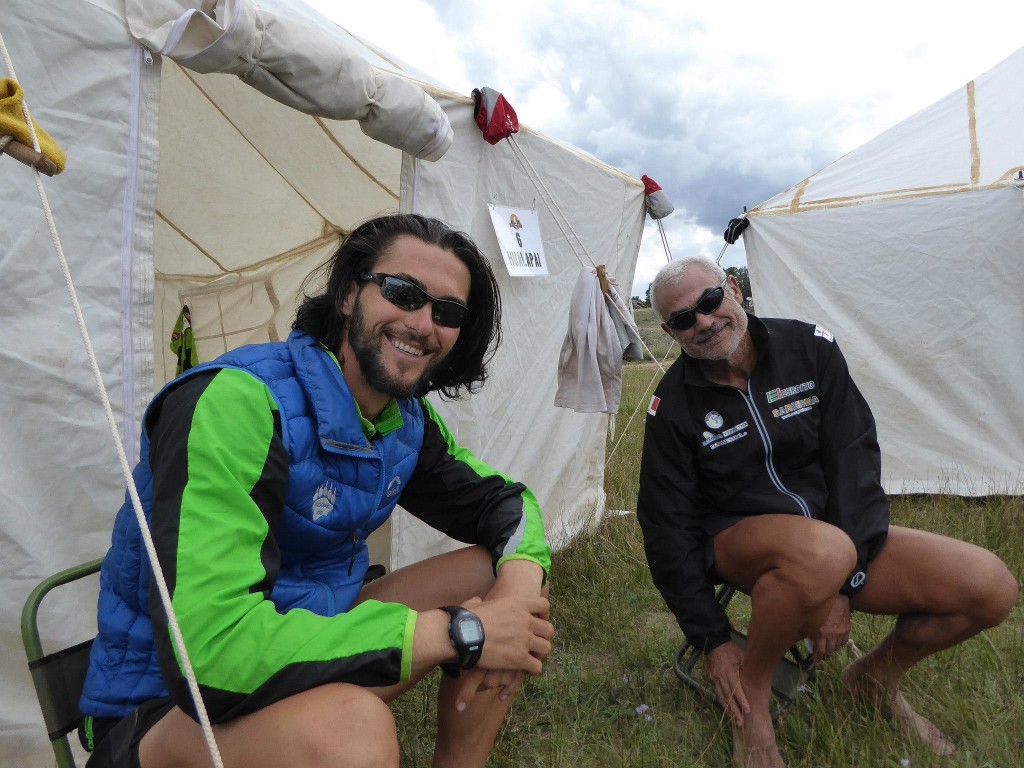
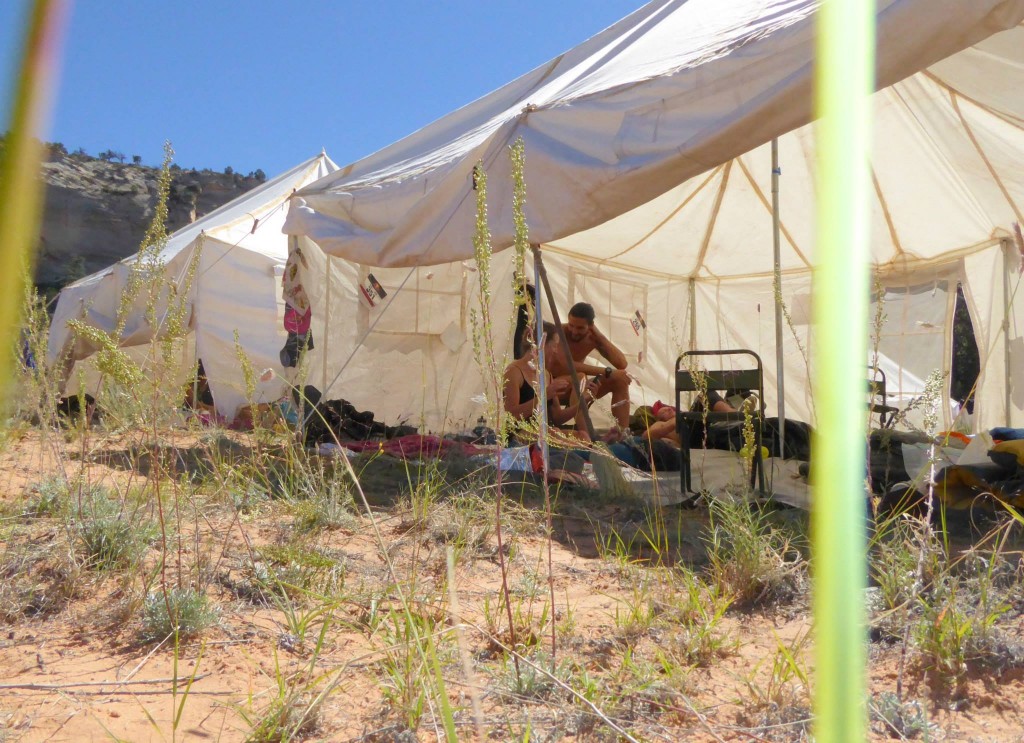
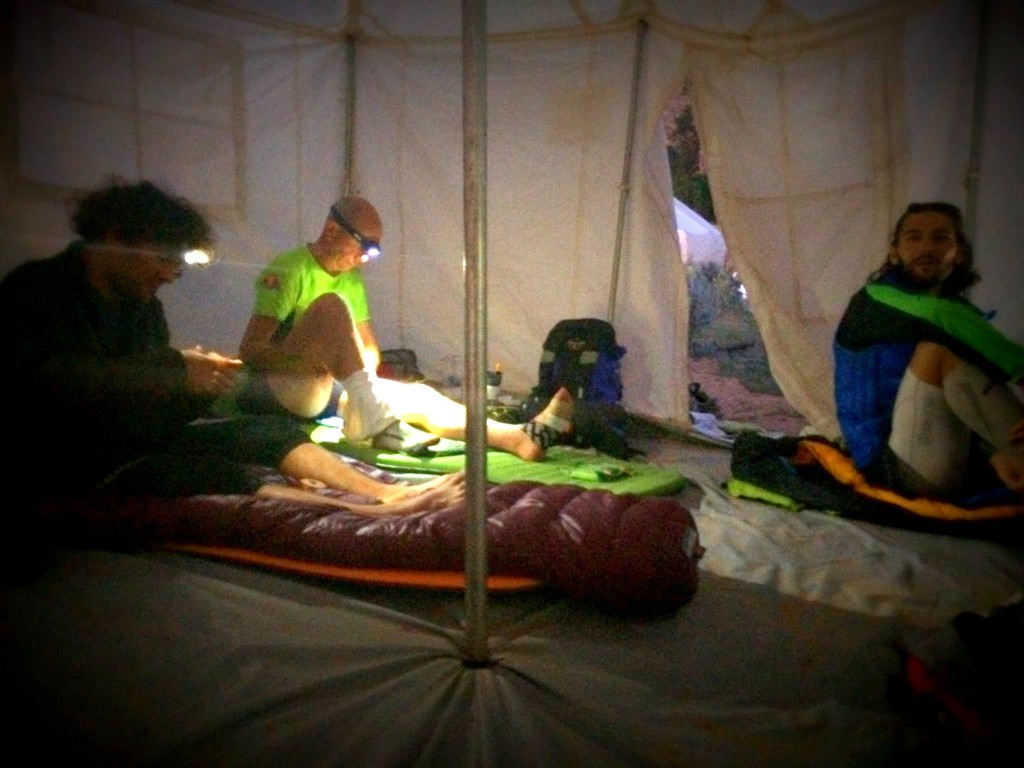
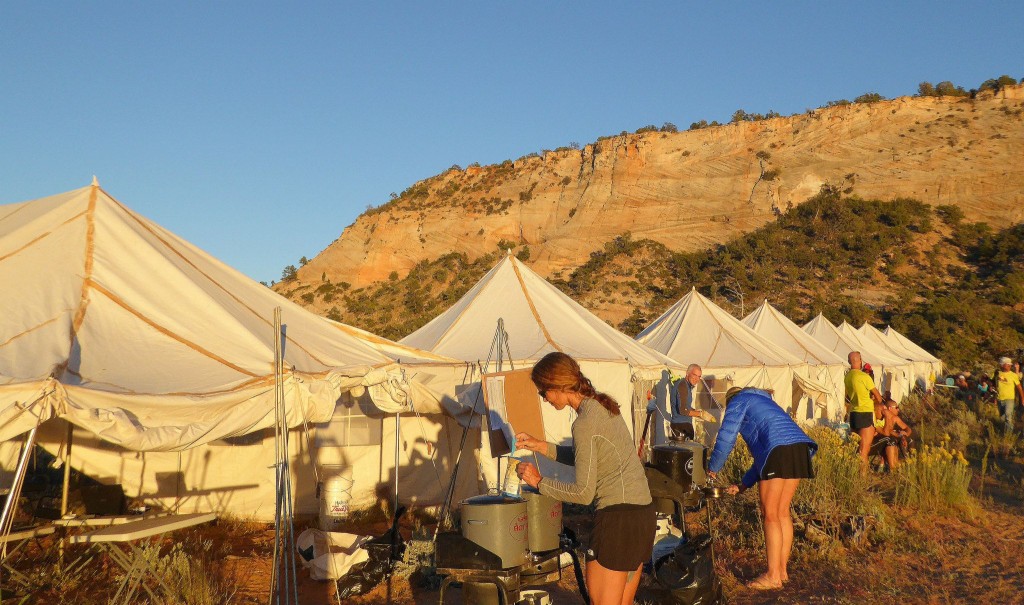
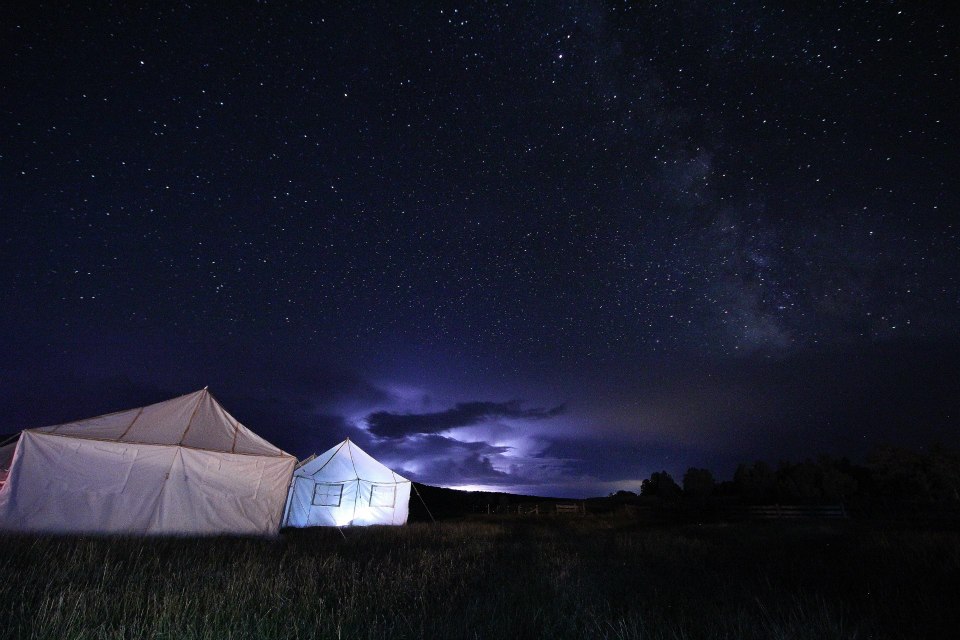
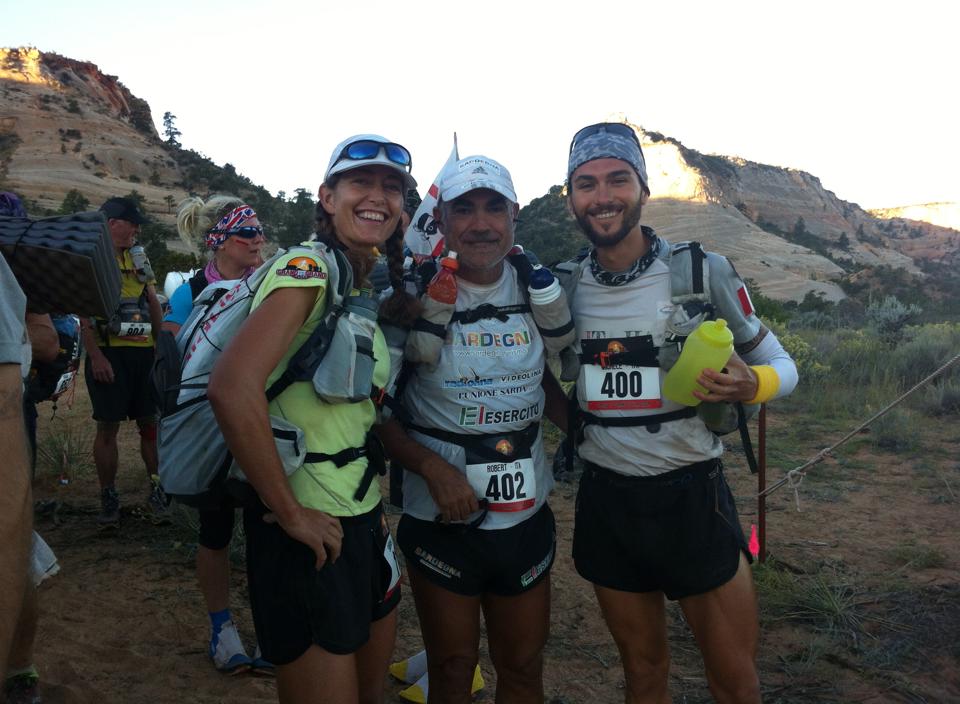
Amazing race!!!!! Great stuff in here. THough wondering why to get enough calories and limit weight you don’t use something like a carbo-pro powder. Carry the powder, mix with water…and you’ve got lots of calories. I’m still trying to master the marathon so there’s probably something about it I don’t know!
Good times Cocoa Butter!
Thanks, Texas! Look me up if you’re ever in Northern California.
Sarah,
After reading far too many crappy student essays, it is such a pleasure to come across something wonderfully well written. Just read this aloud to Karen as she cooked stir fry. We both loved your vivid account and can’t wait for the next installment!
Awesome post, Sarah! Run and recover, indeed. This is making me nostalgic already. In re to mizunogirl, everyone uses a different mix of race fuels and nutrition to get through. For this race, I used carbpro for what I liked to call “background calories,” that is, calories which I could effortlessly consume alongside my hydration regime — a combination of nuun, carbpro, electrolyte tablets and plain water, mixed (or not) at different proportions depending on my needs and mood at different points in the race. Ultimately, over the course of seven days you just can’t get by on powdered calories and electrolytes alone. You need food, and lots of it! And while almost any type of food will do in theory, you also have to be concerned with pack weight, so dehydrated foods become essential. Based on my limited experience, conversations around food and nutrition, and when and how to get your fuel needs met, are nearly limitless! If I had a redo I’d add even a few more junk food treats to my pack and go lighter on the so-called race fuels like gu’s, gels, etc. when you are deep into multi-stage race, the smallest taste of a comfort food, like a bag of salt n’ vinegar potato chips for me, can be an ecstasy-inducing experience and helps humanize an experience that often feels otherworldly and debilitating.
The backwards shirt sounds so much like something I would do! I’m pretty sure I would have been banished from the communal tent for all my snoring and such. I love this look into the inner workings of an event like this; I cannot imagine participating but there is a tiny part of me that thinks it would be fun. A very tiny part.
I love this write up. It reminds me of our bike trip this summer, although we were biking 50K a day, not running it. I felt so full at the end of the day, just filled up with seeing so much beauty. I was a total zombie at the end of each day though, I would just lay down in the tent, desperate to sleep while the kids jumped on me — literally they would just sit on my stomach and bounce or run around the tent banging into the walls — and Drew would unpack the bikes. What a gorgeous piece of writing though, it really has inspired me. You look like you’re 20 years old in these photos!
Folks: that comment is from one of my very favorite world travelers and bloggers. Check out almostfearless.com. Christine helped inspire our round-the-world nomadic year back in 2009-10. This comment means a lot to me. Now I plan to help Christine achieve her own running goals. 🙂 Thanks, Christine!
Beautiful write-up, Sarah. God it makes me miss being dirty and smelly and outside sleeping in the dirt.
Can’t wait for part two!